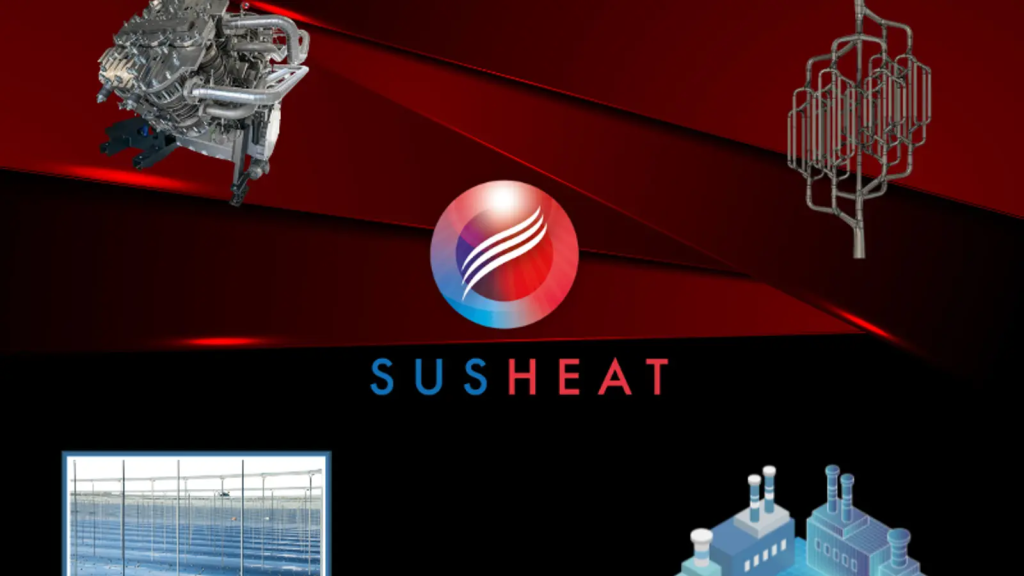Industrial heat remains the silent giant of Europe’s energy system. Roughly half of industrial final energy is used as heat – and much of it is still produced by fossil fuels or lost as low grade waste.
SUSHEAT targets this underused resource by upgrading, storing and distributing heat so factories can meet process temperatures reliably while reducing their carbon footprint.
Europe’s path to climate neutrality by 2050 elevates industrial heat decarbonisation to a strategic technology. Policies under the European Green Deal and the European Climate Law anchor the 2050 neutrality goal and set a steeper 2030 trajectory, increasing the value of solutions that reduce fuel consumption, lower exposure to carbon pricing and enable electrification.

What is SUSHEAT?
SUSHEAT (Smart Integration of Waste and Renewable Energy for Sustainable Heat Upgrade in Industry) is a Horizon Europe Research & Innovation Action developing a next-generation high-temperature heat solution for processes up to 250°C. The project launched on 1 May 2023 and runs for 48 months. The 14-partner consortium spans eleven European countries.
At its core, SUSHEAT integrates:
• Stirling-based high temperature heat pump using helium (R704) as the working fluid, engineered for 150–250°C output;
• Bio-inspired thermal energy storage harnessing the properties of a phase-change material;
• Concentrating solar thermal via linear Fresnel collectors; and
• AI-enabled control and integration twin for real-time optimisation and seamless plant integration.
Why this matters
EU industrial heat demand amounts to ~1,600TWh per year, a scale that makes incremental gains insufficient. Importantly, a large share of process heat sits in the 100–200°C band – prime territory for efficient electrified heat upgrade.
Independent assessments estimate ~26% (≈500TWh/a) of Europe’s industrial process heat lies between 100 and 200°C. These are the very ranges SUSHEAT targets.
Electrifying heat in these ranges can deliver material CO2 reductions, particularly when paired with waste heat recovery, renewables and storage.
EU statistics also show the industrial sector still relies heavily on fossil fuels (e.g. gas and coal), underscoring the need for proven, retrofit-friendly alternatives that reduce fuel risk and carbon cost without compromising uptime or product quality.
How SUSHEAT works
Heat upgrade with high temperature heat pump
SUSHEAT’s Stirling-based high temperature heat pump raises low-grade heat sources – waste heat, ambient or solar input – up to 150–250°C, delivering hot water, steam and thermal oil at high output temperatures. The heat pump used in the SUSHEAT concept achieves a performance coefficient (COP) of 2.8 with a temperature ratio of 1.26, operating in a temperature range between 165-200°C.
Thermal energy storage
The phase change material bio-inspired thermal energy storage decouples heat supply from demand, enabling peak shaving, load shifting and improved use of recovered/renewable heat. By stabilising thermal supply, the storage reduces peak purchases and enhances operational resilience – key for continuous manufacturing.
Solar thermal integration
Linear Fresnel collectors add a compact, modular renewable heat source that can feed the heat pump, the process or the thermal storage. Commercial Fresnel systems are designed for medium temperature industrial process heat and can be deployed on roofs or ground, providing valuable diversity in the heat mix where direct normal irradiance is sufficient.
Digital control
The control and integration twin functions as a digital twin and supervisory brain, sizing, scheduling the thermal storage and coordinating sources in real time. By learning from operators and simulations, the twin supports predictive operation, quality assurance and cost-optimal dispatch, easing integration into existing DCS/SCADA environments.

Where it applies
Many food and beverage duties (e.g. pasteurisation, sterilisation, CIP, drying, baking) operate in stable medium temperature ranges with recoverable heat – well-suited to SUSHEAT’s upgrade plus storage approach.
Textiles (dyeing, finishing) and portions of chemicals/petrochemicals and metals/nonferrous (pretreatment, washing, drying, curing) show similar profiles.
Critically, these are high-hours-of-use processes, strengthening the business case for electrified heat.
For plant managers, SUSHEAT’s value proposition focuses on:
• Lower energy intensity, by using waste heat and solar thermal where viable;
• Cost reduction, via storage-enabled peak management and reduced fuel exposure;
• Operational continuity, using digital diagnostics and predictive scenarios; and
• Sustainable performance, aligning with EU climate policy and strengthening eligibility for green finance or incentives.
Use cases
Two use cases are planned to validate the SUSHEAT pathway.
The Mandrekas pilot at a dairy in Greece is assessing high temperature heat pump integration for pasteurisation and cleaning-in-place (CIP), with thermal energy storage for flexibility and solar thermal as a supplementary source.
The Pelagia pilot at a fish meal and oil facility in Norway is upgrading waste heat for drying and processing of fish oil and animal feed and stabilising thermal supply with digital control.
Enerin’s HoegTemp high temperature heat pump shows a COP of 1.9 with a 1.52 temperature ratio for these systems for temperatures ranging 70-250°C. Live and simulated data from Mandrekas will be used to validate the SUSHEAT system during testing at the KTH labs.
Interim project outputs (public deliverables and publications) are being made public as they are finalised, enabling stakeholders to follow progress and assess relevance to their assets.
Looking ahead
SUSHEAT’s architecture – high temperature heat pumps + storage + solar thermal + digital twin – embodies a collaborative path where research, industry and policy converge.
By unlocking the potential of waste heat and renewables, SUSHEAT is paving the way for a sustainable, competitive, climate-neutral industrial future.



